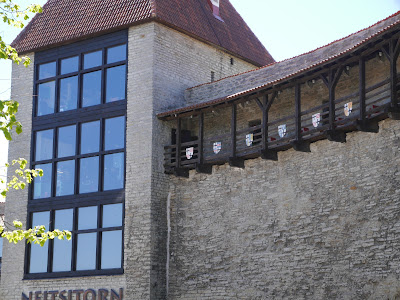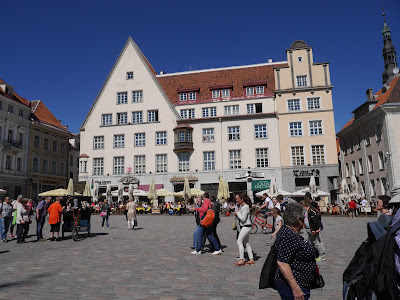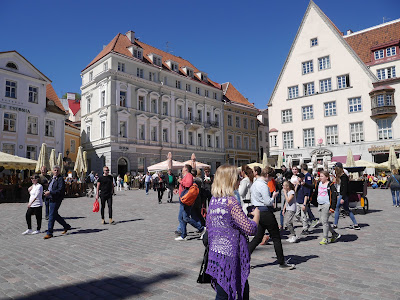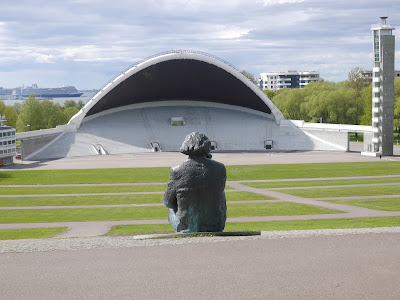We
arrived in Tallinn at 11am having put our clocks forward a further hour
overnight. Tallinn is 2 hours in front of
the UK.
Tallinn
had been on my bucket list for about 10 years.
I used to organise customer trips for IBM and Lenovo and took a customer
from Tallin to Beijing once. He sold me
on the town and I just hoped it would live up to expectation.
Tallinn's
Old Town is one of the best preserved medieval cities in Europe and is listed
as a UNESCO World Heritage Site. It is ranked as a global city and has been
listed among the top 10 digital cities in the world and is the birthplace of
Skype. The city was a European Capital
of Culture for 2011, along with Turku in Finland.
We
jumped ship and wandered down the quay to find our guide.
Our
guide for today was Janna who took us up to the Old Town of Tallin. This is Toompea Castle which sits on Toompea
hill. The castle, an ancient stronghold site in use since at least the 9th
century, today houses the Parliament of Estonia. In 1219, the castle was taken over by Danish
crusaders led by Valdemar II. In 1227,
the castle was taken over by the Order of the Brethren of the Sword, who
initiated rebuilding schemes. The castle they started building is to a large
extent the castle that is visible today. The castle again befell the Danes just
ten years later, but was sold to the Teutonic Order in 1346, and would remain
in their hands for the remainder of the Middle Ages. By 1561, northern Estonia
had become a Swedish dominion. The Swedes transformed the castle from a
crusaders' fortress into a ceremonial and administrative centre of political
power in Estonia, a purpose the castle has served ever since. In 1710, Sweden lost the territory of
modern-day Estonia to the Russian Empire. The Russian administration eventually
carried out large reconstruction schemes and turned the castle definitively
into a palace.
The
Parliament building.
The
Alexander Nevsky Cathedral is an orthodox cathedral in the Tallinn Old Town,
Estonia. It was built to a design by Mikhail Preobrazhensky in a typical
Russian Revival style between 1894 and 1900, during the period when the country
was part of the Russian Empire. The Alexander Nevsky Cathedral is Tallinn's
largest and grandest orthodox cupola cathedral. It is dedicated to Saint
Alexander Nevsky who in 1242 won the Battle of the Ice on Lake Peipus, in the
territorial waters of present-day Estonia.
We weren’t allowed to take photos inside but it is very ornate.
Next
was St. Mary’s Cathedral. Originally a
Roman Catholic cathedral, it became Lutheran in 1561 and now belongs to the
Estonian Evangelical Lutheran Church
The
first church was made of wood and built by 1219. The church suffered considerable damage in
the great fire of 1684 when the entire wooden furnishings were destroyed. Some
vaults collapsed and many stone-carved details were severely damaged-
especially in the chancel. In 1686, after the fire, the church was practically
rebuilt to restore it to its previous state.
Historically this was the church of Estonia's elite German nobles, a
fact that becomes clear once you step through the doors. The interior is filled
with elaborate funereal coats of arms from the 17th to the 20th centuries as
well as burial stones from the 13th to the 18th centuries.
We
found a lovely spot to look at the lower town of Tallinn. I love roofs.
We
started our decent into the Lower Town.
Our first stop was just through a gate in the Town Wall. The first wall around Tallinn was constructed
in. This wall was less than 16 feet tall and about 4 feet 9 inches thick at its
base. Since that time it has been enlarged and strengthened. The walls and the
many gates are still largely extant today. This is one of the reasons that
Tallinn's old town became a World Heritage Site. The walls were enlarged in the
fourteenth century, and citizens of Tallinn were required to turn out for guard
duty, which meant to wear their armour and demonstrate their readiness to face
off invaders.
As we
left to go into the Lower Town we came across three statues of faceless
monks. I know our guide told us a story
about them but for the life of me I can’t remember it and even though I can
find lots of references to the monks on the internet there is no story as to
why they are there.
We
walked down the steep hill and into the Town Hall Square. Historically the square served as a market
and meeting place, and was the site of at least one execution (resulting from a
dispute over a bad omelette). It was
buzzing and is great as no cars are allowed.
Janna
took us to a restaurant for lunch. It
only a snack but we had black rye bread, ham and pickles with an apple turnovery
thing!
After
lunch we visited an old pharmacy. The
first part is still a working pharmacy but the second room is a small museum.
This
is the smallest house in Tallinn which was the house of the priest.
Our
next stop was Katariina Käik (St. Catherine's Passage) which is easily the most
picturesque of Old Town's lanes, this half-hidden walkway runs behind what used
to be St. Catherine's Church. What makes
the passage particularly interesting is that it's home to the St. Catherine's
Guild, a collection of craft workshops where artists use traditional methods to
create and sell glassware, hats, quilts, ceramics, jewellery, hand-painted silk
and other wares. The workshops are housed in the small, 15th- to 17th-century
rooms on the south side of the lane, and are set up in an open-studio fashion
so visitors can watch the artists at work, be it glass-blowing, weaving or
pottery making.
We
were then given 20 minutes of free time to do some shopping! It was such a shame as I could have spent
ages walking through the Wool Market but I only had time to buy a woolly hat
for my grandson.
The
next was the Presidential Palace. For a
few years during Estonia's first period of independence (1918 - 1940), the
Estonian head of state worked out of the Kadriorg Palace, but in 1938, the
purpose-built presidential palace was opened next to it, just up the hill. The
Presidential Palace's style echoes the Kadriorg, albeit without quite so much
flourish. Since the building once again serves as the President's office and
residence, it's closed to visitors, but you can still wander into the parking
area for a better view and, if your timing is lucky, you'll see the honour guards
marching out front. It seemed very
strange to be able to get so close to where the President lives.
However
the present President, Kersti Kaljulaid, doesn’t live there. She has chosen to live in her own house
causing a few problems with security.
She is her own woman and only appears to do what she wants to do and not
what is expected of her.
Our
next and final stop on our whistle stop tour was the Tallinn Song Festival
Grounds. The Estonian Song Festival is
one of the largest amateur choral events in the world. It is held every five
years in July on the Tallinn Song Festival Grounds simultaneously with the
Estonian Dance Festival. The joint choir has comprised more than 30,000 singers
performing to an audience of 80,000. The
last festival in 2014 was the 26th with the first one held in 1869. The tower boasts a flame while the festival
is taking place.
Back
at the ship we had dinner and collapsed!
I was
not disappointed in Tallinn whatsoever – it would have been nice to have had
more time though. They seem to be a very
happy nation and are enjoying the freedom which they got back when they
regained independence in 1991 in the course of the dissolution of the Soviet
Union and joined the European Union and NATO in 2004.
“There
is nothing more beautiful that the way that the ocean refused to stop kissing
the shoreline, no matter how many times it is sent away.” Sarah Kay










































No comments:
Post a Comment